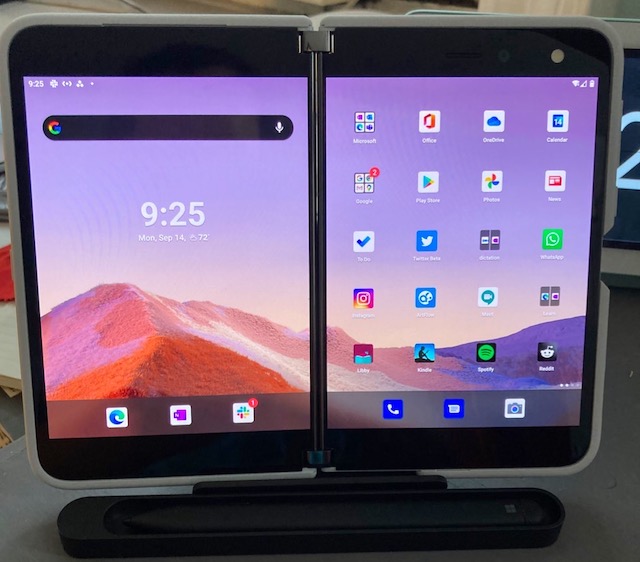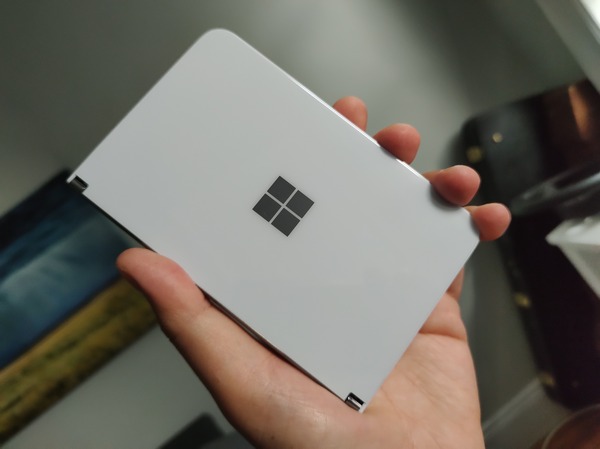Review: Microsoft Surface Duo
 Tuesday, December 15, 2020 at 2:31PM
Tuesday, December 15, 2020 at 2:31PM  By Gadjo Cardenas Sevilla
By Gadjo Cardenas Sevilla
By now you’ve probably read the scathing reviews of Microsoft’s ambitious and expensive new device. Initially available only in the US for $1400 but now coming to Canada as well. Surface Duo is Microsoft’s first Android device, and it was built with Google’s collaboration.
We’re seeing different takes on larger mobile devices like folding smartphones and even LG’s strange Wing device with a t-shaped screen array. The Surface Duo is composed of two screens that can be used independently or together in various ways. Which makes it more versatile than a three-screen folding phone, if you don’t mind the seam in the middle where the hinge resides.
Designed around productivity, Surface Duo is built for multitasking and is capable of running two apps at the same time. It is also for spanning one app a cross the makeshift 8-inch display (composed of two 5.6-inch AMOLED displays connected by a hinge. Hit jump for our review.
Exquisite Design

The Duo’s design is exquisite and decisively premium. It is completely encased in Gorilla Glass and it is unbelievably thin, not much thicker than a USB Type-C port. Even when folded, the Surface Duo is not much thicker than an iPhone 11 or a Galaxy Note. The heart of the Duo is the articulating hinge that enables a full 360’ rotation of the dual screens.
This allows multiple modes of use or ‘postures’ including single screen mode, tablet mode, tent mode, and compose mode. The disadvantages of the Surface Duo’s design are that you can’t see notifications when it is closed and the single 11-megapixel selfie camera is not great for taking photos or video. To create such a slim device, Microsoft had to sacrifice some features, among them are 5G connectivity, a headphone jack, NFC connectivity, and water resistance.
In terms of software, Surface Duo runs Android 10 with some Microsoft modifications to handle the multi screen experience. Most apps run well side by side, you can have Instagram and a web browser open at the same time, Netflix and Chrome, Instagram and Google Photos, Kindle reader and OneNote.
Dual screens shine for certain apps like maps which can take up the whole screen and display additional information. Gamers have also made use of one screen for the game and the lower screen for controls. Although, the Surface Duo runs last year’s flagship specs (Qualcomm Snapdragon 855 with 6GB of RAM), it feels reasonably fast. An update to Android 11 is forthcoming and should solve some of the quirks experienced, but I’m not holding my breath.
This review was written entirely on the Surface Duo on Microsoft Word, with me thumb typing and using the keyboards autocomplete feature. I’d much prefer using an external Bluetooth Despite being a Surface product, you can’t dock Surface Duo into a monitor, keyboard and mouse to get a desktop experience. Doing this simply blows up Android into a bigger screen, which is a missed opportunity.
Surface Duo can take pen input, but it is nowhere as sophisticated as Samsung’s S Pen. Using a Surface Pen on the Duo makes it feel like a very high tech and exorbitantly priced Moleskine notebook. In book mode running eReader apps like Amazon Kindle, Surface Duo offers the most immersive reading experience as you can hold it just like a softcover book. Surface Duo beats any smartphone for video calls because you can have the call on one screen and have the other screen open for taking notes.
A Flawed Bauble
I owned and used the Surface Duo as my personal device for three months. I was happy to own an unusual and versatile device but, in the end, I sold the Surface Duo and the Surface Slim Pen, here’s why. Aside from a unique form factor and convenience of having two screens, the Surface Duo fails to bring anything new to the smartphone space. It can’t replace a tablet, or a laptop, and it can barely function as a phone. After the most recent monthly update, my Surface Duo’s touch functionality would refuse to work during calls.
This meant I had to shut of the Duo to disconnect from phone calls. I couldn’t even access the touchpad to navigate Microsoft’s support phone line. Even with my larger hands, I found it tedious to fumble and flip the displays open just to check messages or answer calls. I was also dismayed, but not surprised, to realize that very few Android apps make sense on two-screens. Was three months enough for me to give this new form factor a chance? Absolutely. As slick and novel as the Surface Duo is, it feels like an incomplete product and there’s just too much uncertainty in its future and its rough edges cut deeply.
Surface Duo is not going to satisfy smartphone buyers because it presents a different use case which won’t work for one-handed use. Two-screens are cool, and useful, but only for a handful of applications. I tried to fit the Surface Duo into my life. I desperately wanted it to work out, but in the end, it fell short as a phone, a camera, and as a Surface device.
Rating: 6 out of 10




















Reader Comments